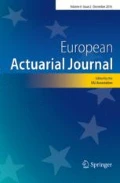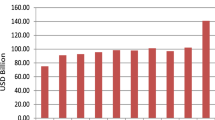Abstract
We address some issues in agricultural insurance, describing drawbacks of the bonus-malus system (BMS) methodology used in Spain and many other EU countries. We develop an alternative experience based premium rate discount system taking into account the adverse years when high losses caused by extreme weather events happen. Our contribution consists of a two-step methodology. Firstly, we use tobit or Tweedie regressions to calculate yearly correction rates. Secondly, we calculate the mean of the correction rates. This average model acts as a buffer against adverse year losses. We compare three alternatives: our two resulting average models and the BMS operating in the Spanish line of business exemplified—table grapes.
Similar content being viewed by others
Notes
In the US there are several practical implementations of the idea of experience-based ratemaking. One reviewer let us know that US rating procedures ‘fine-tune’ base rates according to historical average yields. Since a higher average yield leads to a rate decrease, farms with higher average yields will have lower relative risk. Also, the Risk Management Agency (RMA) has implemented a biotech discount, lowering the premiums to those farmers that use modern technologies. In addition, discounts are also offered to producers taking coverage at higher levels of aggregation, see [14].
See [5] for an alternative Bayesian approach to weighting the experience in order to deal with extreme weather events.
The Tweedie distribution depends on a parameter p, known as the ‘index parameter’, and the different values of this parameter allow to obtain as particular cases some important continuous, discrete and mixed distributions. For example, the Normal, Poisson and Gamma are particular cases of a Tweedie distribution with p = 0, 1 and 2, respectively. When 1 < p < 2, the Tweedie becomes a Poisson-Gamma compound distribution. This is precisely the interesting case for us, because it is a mixed distribution with a discrete mass of probability assigned to zero (interpreted as the probability of no claims) and a positive continuous part (interpreted as the density of the claim amounts). For information about the Tweedie distribution see Chapter 12 of [8], and for its ratemaking applications, see [13]. Regarding the Tobit model, it can also be considered as a mixture of a claim/no claim binary distribution and a truncated normal distribution giving the density of the positive claim amounts, see [16]. Although this decomposition makes sense in insurance problems, it is rarely found in the actuarial literature.
The Spanish “Consorcio de Compensación de Seguros” (CCS), is a public business entity attached to the Spanish Ministry of Economy. The CCS relies on its own capital, without any dependence of public funds. From the agricultural insurance perspective, it develops three main lines of activity, playing a key role as a system compulsory reinsurer, monitoring loss adjustments and participating in the coinsurance scheme. The involvement of the CCS in the Spanish system of agricultural insurance is crucial since it decreases the impact of losses making possible risk underwritings.
For more information, see Sect. 14. Bonificaciones y Recargos in the document Seguro de Explotaciones de Uva de Mesa: condiciones especiales (in Spanish) https://agroseguro.es/fileadmin/propietario/Productos/AGRICOLAS/321%20UVA%20DE%20MESA/PLAN_2018/CES-321-18-1.0.pdf
The selection of \(n=5\) years for the return period has been based on the fact that we can find both favourable and unfavourable years within this period, as we can check in Tables 1, 2 and 3. Rejesus et al. also choose a period of 5 years for the analysis, based on different considerations: “The choice of five years is arbitrary but reflects a balance between a longer period (that would have greater statistical power) and choosing a shorter period (that would make it possible for more producers to qualify but would have lower statistical power)” (see [21], pg. 414).
It is important to highlight that the empirical factors \({F}^{(-t)}, t\in \{1,\dots ,5\}\), were always significant in all the Tobit and Tweedie regressions. For the numerical calculations, we used the R packages ‘AER’ (https://cran.r-project.org/web/packages/AER/AER.pdf) and ‘tweedie’ (https://cran.r-project.org/web/packages/tweedie/tweedie.pdf).
The outputs of the statistical procedures are available to the readers upon request.
The values of the mse have been calculated using the Leave One Out Cross Validation (LOOCV) method.
In order to reach the financial equilibrium, we should multiply the Mean Tobit Premiums by \(\frac{9,818}{\mathrm{9,828}}\), and the Mean Tweedie Premiums by \(\frac{\mathrm{9,818}}{\mathrm{9,636}}\).
References
Anemiya T (1984) Tobit model: a survey. J Econom 24:3–61
Annan F, Tack J, Harri A, Coble K (2013) Spatial pattern of yield distributions: implications for crop insurance. Am J Agr Econ 96(1):253–268
Bielza M, Conte C, Gallego F, Stroblmair J, Catenaro R, Dittman C (2009) Risk management and agricultural insurance schemes in Europe.https://ec.europa.eu/jrc/en/publication/eur-scientific-and-technical-research-reports/agricultural-insurance-schemes
Borgan O, Hoem J, Norberg R (1981) A non-asymptotic criterion for the evaluation of automobile bonus systems. Scand Actuar J 165–178
Borman JI, Goodwin BK, Coble KH, Knight TO, Rejesus R (2013) Accounting for short samples and heterogeneous experience in rating crop insurance. Agric Financ Rev 73(1):88–101
Denuit M, Maréchal X, Pitrebois S, Walhin J (2007) Actuarial modelling of claim counts. Wiley, Hooken
Duarte G, Braga A, Miquelluti L, Ozaki V (2018) Modeling of soybean yield using symmetric, asymmetric and bimodal distributions: implications for crop insurance. J Appl Stat 45(11):1920–1937
Dunn PK, Smyth GK (2018) Generalized linear models with examples in R. Springer, New York
Gareth J, Witten D, Hastie T, Tibshirani R (2013) An introduction to statistical learning. Springer, New York
Hasti T, Tibshirani R, Friedman J (2009) The elements os statistical learning data mining, inference and prediction. Springer, New York
Heras A, Gil J, García P, Vilar-Zanón J (2004) An application of linear goal programming to bonus malus system design. Astin Bull 34:435–456
Heras A, Vilar-Zanón J, Gil J (2002) Assymptotic fairness of bonus malus systems and optimal scales of premiums. Geneva Pap Risk Insur-Theory 27:61–82
Jorgensen B, Paes de Souza M (1994) Fitting Tweedie's compound model to insurance claims data. Scand Actuar J 1:69–93
Knight T, Coble K, Goodwin B, Rejesus R, Seo S (2010) Developing variable unit-structure premium rate differentials in crop insurance. Am J Agr Econ 92(1):141–151
Lemaire J (1995) Bonus malus systems in automobile insurance. Kluwer academic publishers, Dordrecht
McDonald J, Moffitt R (1980) The uses of Tobit analysis. Rev Econ Stat 62(2):318–321
Norberg R (1976) A credibility theory for automobile bonus system. Scand Actuar J 92–107
Ozaki V, Silva R (2009) Bayesian ratemaking procedure of crop insurance contracts with skewed distribution. J Appl Stat 36(4):443–452
Ozaki V, Goodwin B, Shirota R (2008) Parametric and nonparametric statistical modelling of crop yield: implications for pricing crop insurance contracts. Appl Econ 40(9):1151–1164
Pesonen M (1963) A numerical method of finding a suitable bonus-malus scale. Astin Bull 2:102–118
Rejesus R, Coble K, Knight T, Jin Y (2006) Developing experience-based premium rate discounts in crop insurance. Am J Agr Econ 88(2):409–419
Shen Z, Odening M, Okhrin O (2018) Adaptive local parametric estimation of crop yields: implications for crop insurance rate making. Eur Rev Agric Econ 45(2):173–203
Skees J, Reed M (1986) Rate making for farm-level crop insurance: implications for adverse selection. Am J Agr Econ 68(3):653–659
Tolhurst T, Ker A (2014) On technological change in crop yields. Am J Agr Econ 97(1):137–158
Woodard J, Sherrick J, Schnitkey G (2011) Actuarial impacts of loss cost ratio ratemaking in U.S. crop insurance programs. J Agric Resour Econ 36(1):211–228
Zheng Q, Wang H, Shi Q (2014) Estimating bivariate yield distributions and crop insurance premiums using nonparametric methods 46(18):2108–2118
Acknowledgements
This work was supported by Agroseguro under UCM contract number 437-2016. The authors are very thankful to Pablo Ezquerra and Felix Novoa from AGROSEGURO, for their helpful comments and suggestions.
Author information
Authors and Affiliations
Corresponding author
Additional information
Publisher's Note
Springer Nature remains neutral with regard to jurisdictional claims in published maps and institutional affiliations.
Rights and permissions
About this article
Cite this article
Vilar-Zanón, J.L., Heras, A. & de Frutos, E. An average model approach to experience based premium rates discounts: an application to Spanish agricultural insurance. Eur. Actuar. J. 10, 361–375 (2020). https://doi.org/10.1007/s13385-020-00234-1
Received:
Revised:
Accepted:
Published:
Issue Date:
DOI: https://doi.org/10.1007/s13385-020-00234-1




